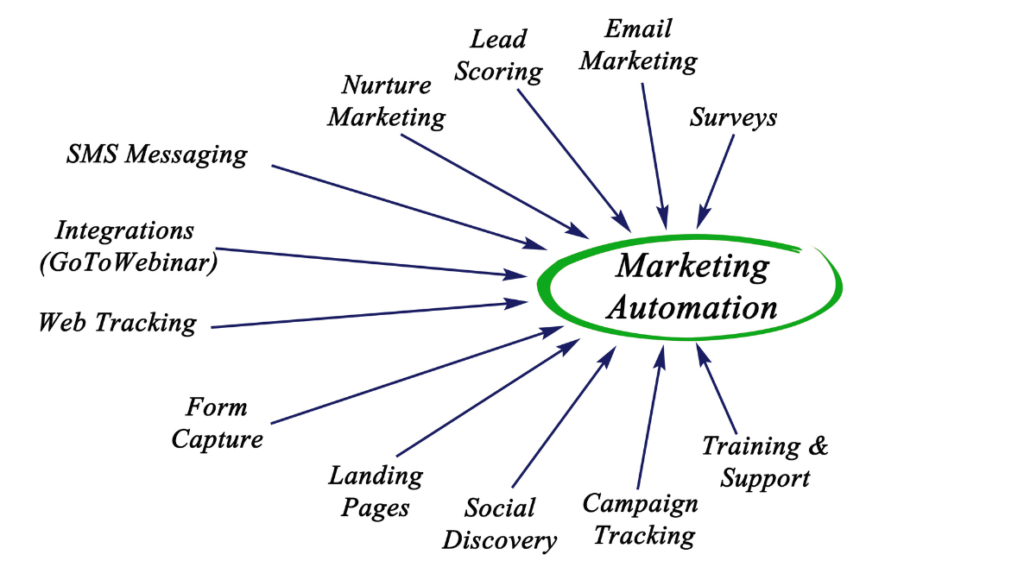Unlocking the Power of Marketing Automation: A Guide for Business Growth

Businesses are continuously looking for methods to improve customer engagement, streamline processes, and increase revenue in today’s fast-paced digital environment. Marketing automation is one of the most successful tactics that is gaining traction. We’ll dive into the world of marketing automation in this thorough guide, going over its essential elements, advantages, deployment techniques, and upcoming trends.
Table of Contents
ToggleIntroduction

To put it simply, marketing automation is the process of using technology to automate workflows and repetitive tasks related to marketing. Automation tools enable businesses to efficiently deliver personalized and targeted content to their audience, from email campaigns to social media management and lead nurturing.
What is marketing automation?
The term “marketing automation” describes the process of automating routine marketing tasks and workflows using software and technology. It enables companies to boost productivity, simplify their marketing campaigns, and provide audiences with individualized experiences on a large scale. Businesses can use marketing automation to automate a number of marketing campaign tasks, such as lead generation, email marketing, social media management, and customer relationship management (CRM).
Fundamentally, the goal of marketing automation is to streamline and enhance the marketing process by utilizing sophisticated algorithms and data analytics to send prospects and customers timely, relevant communications. By automating tasks such as email sends, lead scoring, and campaign tracking, businesses can save time and resources while ensuring consistent and relevant messaging across multiple channels.
Key Components of Marketing Automation
Customer Relationship Management (CRM): At the core of marketing automation lies CRM software, which enables businesses to manage interactions with current and potential customers. By centralizing customer data, businesses can better understand their audience and tailor marketing efforts accordingly.
- Email Marketing Automation: Sending personalized emails at scale becomes seamless with email marketing automation. From welcome emails to drip campaigns and follow-ups, automation ensures timely and relevant engagement with prospects and consumers.
- Social Media Management: With social media automation tools, organizations can plan posts, track interaction data, and analyze performance across numerous platforms. This enables for continuous and targeted social media presence without the burden of manual publishing.
- Lead Management and Nurturing: Marketing automation streamlines the process of gathering, qualifying, and nurturing leads. Through lead scoring, segmentation, and automated workflows, businesses can identify high-potential leads and guide them through the sales funnel more effectively.
- Analytics and Reporting: Data-driven decision-making is essential for marketing success. Automation platforms provide robust analytics and reporting features, allowing businesses to track campaign performance, measure ROI, and optimize their strategies accordingly.
Benefits of Marketing Automation
- Increased Efficiency and Productivity: By automating repetitive tasks, businesses can free up time for their teams to focus on strategic initiatives and creative endeavors.
- Enhanced Lead Generation and Conversion Rates: Personalized and timely communication with prospects improves lead quality and increases conversion rates.
- Improved Customer Engagement and Retention: Automation enables businesses to deliver targeted content based on customer preferences and behavior, fostering stronger relationships and loyalty.
- Personalization and Targeting: Tailoring messages to specific audience segments enhances relevance and resonates with recipients on a deeper level.
- Cost-effectiveness and ROI: Although deploying automation solutions may have some initial expenses, the long-term advantages in terms of increased productivity and income greatly exceed the outlay of funds.
Automated Marketing Solutions
A vast array of platforms and technologies are included in automated marketing solutions, which are intended to automate monotonous marketing processes and tasks. These solutions, which range from lead nurturing and analytics to email campaigns and social media management, use cutting-edge algorithms and data-driven insights to deliver customized and targeted marketing campaigns at scale.
Implementing Automated Marketing Solutions
Implementing automated marketing solutions involves several key steps:
- Analyze Business Needs and Goals: Determine certain issues and goals, such better lead generation, more sales, or better customer interaction, that automated marketing systems can help with.
- Choose the Right Solution: Research and assess numerous automated marketing platforms based on aspects like as features, scalability, convenience of use, and pricing. Consider your budget and integration requirements to ensure compatibility with existing systems.
- Integration and Onboarding: Ensure seamless integration with existing systems such as CRM, email marketing platforms, and e-commerce platforms. Provide comprehensive training and onboarding for your team to maximize adoption and usage of the new solution.
- Testing and Optimization: Continuously monitor and evaluate campaign performance indicators to discover areas for improvement. Experiment with different messaging strategies, audience segments, and automation workflows to optimize results and drive better outcomes.
Implementing Marketing Automation Software
Implementing marketing automation software involves several key steps:
- Research and Evaluation: Research and evaluate different marketing automation software solutions based on your business needs, budget, and desired features. Integration and Onboarding: Ensure seamless integration with existing systems such as CRM, email marketing platforms, and e-commerce platforms. Provide comprehensive training and onboarding for your team to maximize adoption and usage of the new software.
- Campaign Setup and Optimization: Set up automated campaigns and workflows based on your marketing objectives and target audience. Test different messaging strategies, audience segments, and automation workflows to optimize results and drive better outcomes.
- Monitoring and Analysis: Continuously monitor the performance of your campaigns using the analytics and reporting tools supplied by the marketing automation software. To evaluate the success of your campaigns and make data-driven decisions for further optimization, monitor important metrics and KPIs.
Implementing Marketing Analytics
Several essential steps are involved in implementing marketing analytics:
- Establish Goals and KPIs: Make sure your marketing goals and key performance indicators (KPIs) are in line with your corporate objectives. This offers a structure for gauging accomplishment and monitoring development over time.
- Choose the Correct Analytics Tools: Make sure the platforms and tools you select for analytics meet the goals and needs of your company. Take into account elements like reporting features, scalability, ease of use, and data integration capabilities.
- Gather and Arrange Data: Put in place methods for gathering pertinent information from a range of sources, such as social media channels, email marketing platforms, website analytics, and CRM systems. Ensure that data is organized and structured in a way that facilitates analysis and reporting.
- Analyze and Interpret Data: Use analytics tools to analyze data and derive actionable insights. Identify trends, patterns, and correlations within the data to understand the effectiveness of your marketing efforts and identify opportunities for improvement.
- Act on Insights: Based on the insights generated from your analysis, take strategic actions to optimize your marketing strategies and campaigns. This may involve adjusting messaging, reallocating resources, or experimenting with new tactics to achieve better results.
Implementing Marketing Automation
Before diving into marketing automation, businesses should take the following steps:
- Assess Business Needs and Goals: Identify pain points and objectives that automation can address, whether it’s improving lead generation, increasing sales, or enhancing customer experience.
- Choose the Right Marketing Automation Platform: Research and evaluate different automation tools based on features, scalability, and compatibility with existing systems.
- Integration with Existing Systems: Ensure seamless integration with CRM, email, and other marketing platforms to maximize efficiency and data consistency.
- Training and Onboarding: Provide comprehensive training to teams to ensure they understand how to use the automation platform effectively.
- Continuous Optimization and Testing: Regularly monitor and analyze performance metrics, experimenting with different strategies to optimize results.
Implementing Automated Email Marketing
Implementing automated email marketing involves several key steps:
- Choose the Right Email Marketing Platform: Research and select an email marketing platform that offers robust automation features, scalability, and ease of use.
- Define Your Email Marketing Goals: Clearly define your email marketing objectives, whether it’s increasing sales, nurturing leads, or driving website traffic. This will guide your strategy and help you determine the types of automated campaigns to set up.
- Segment Your Email List: Segment your email list based on relevant criteria such as demographics, purchase history, or engagement level. This allows for more targeted and personalized communication with your subscribers.
- Create Automated Email Workflows: Set up automated email workflows based on user actions and triggers. This could include welcome email sequences for new subscribers, abandoned cart recovery emails for potential customers, or re-engagement emails for inactive subscribers.
- Monitor and Optimize Performance: Regularly monitor the performance of your automated email campaigns using analytics and reporting tools. Test different subject lines, email content, and sending times to optimize your campaigns for maximum effectiveness.
Advantages of Marketing Automation:
- Increased Efficiency: Marketing automation streamlines repetitive tasks, allowing businesses to save time and resources. This efficiency enables teams to focus on strategic initiatives and creative endeavors, ultimately improving productivity.
- Personalized Communication: Automation allows businesses to deliver highly targeted and personalized messages to their audience based on factors such as demographics, behavior, and preferences. This personalized approach enhances engagement and builds stronger relationships with customers.
- Better Lead Management: Automation software facilitates lead scoring, segmentation, and nurturing, enabling businesses to identify high-quality leads and guide them through the sales funnel more effectively. This leads to improved conversion rates and higher ROI on marketing efforts.
- Improved Analytics and Reporting: Marketing automation platforms provide robust analytics and reporting tools that allow businesses to track the performance of their campaigns in real-time. By analyzing metrics such as open rates, click-through rates, and conversion rates, businesses can make data-driven decisions to optimize their strategies.
- Scalability and Flexibility: Most marketing automation software is scalable and flexible to the needs of expanding enterprises. Whether it’s managing a tiny email list or performing complex multi-channel campaigns, automation software can scale to match evolving requirements.
Disadvantages of Marketing Automation:
- Initial Investment: Implementing marketing automation software typically requires an initial investment in terms of both time and money. Businesses may need to allocate resources for software licensing fees, training, and implementation costs, which can be a barrier for smaller organizations with limited budgets.
- Learning Curve: Marketing automation software often comes with a learning curve, especially for teams who are new to the platform. Training and onboarding are essential to ensure that teams can effectively utilize the software’s features and functionalities.
- Risk of Over-Automation: While automation can streamline processes and improve efficiency, there’s a risk of over-automation. Businesses must establish a balance between automation and human touch, ensuring that communication remains authentic and meaningful to the recipient.
- Data Privacy and Compliance: Collecting and storing customer data comes with inherent risks, particularly in terms of data privacy and compliance with regulations such as GDPR. Businesses must implement robust security measures and adhere to data protection laws to safeguard customer information and maintain trust.
- Potential for Technical Issues: Like any software, marketing automation platforms are susceptible to technical issues and downtime. Businesses must have contingency plans in place to limit the impact of technological disruptions on their marketing operations.
Conclusion
Marketing automation provides enormous potential for firms aiming to streamline their marketing activities, promote growth, and create exceptional client experiences. By leveraging automation tools effectively and staying attuned to evolving trends, businesses can unlock new opportunities and stay ahead in today’s competitive landscape.
FAQs
What are the common hurdles in implementing marketing automation?
Common obstacles include data integration concerns, lack of alignment between sales and marketing departments, and ensuring adequate segmentation and targeting.
How can businesses ensure data privacy and compliance while using marketing automation?
Businesses should adhere to data protection regulations such as GDPR and implement security measures to safeguard customer information.
What training and support options are available for staff during the transition to automation?
Many automation suppliers offer training tools, webinars, and customer support to assist firms during the onboarding process.
How can firms measure the performance and ROI of their marketing automation efforts?
Key performance indicators (KPIs) such as conversion rates, lead quality, and customer lifetime value can help firms assess the efficiency of their automation tactics.
What are some recommended practices for sustaining a successful marketing automation strategy?
Regularly update and refine customer segmentation criteria, A/B test different messaging strategies, and stay informed about emerging trends and technologies in the field.




